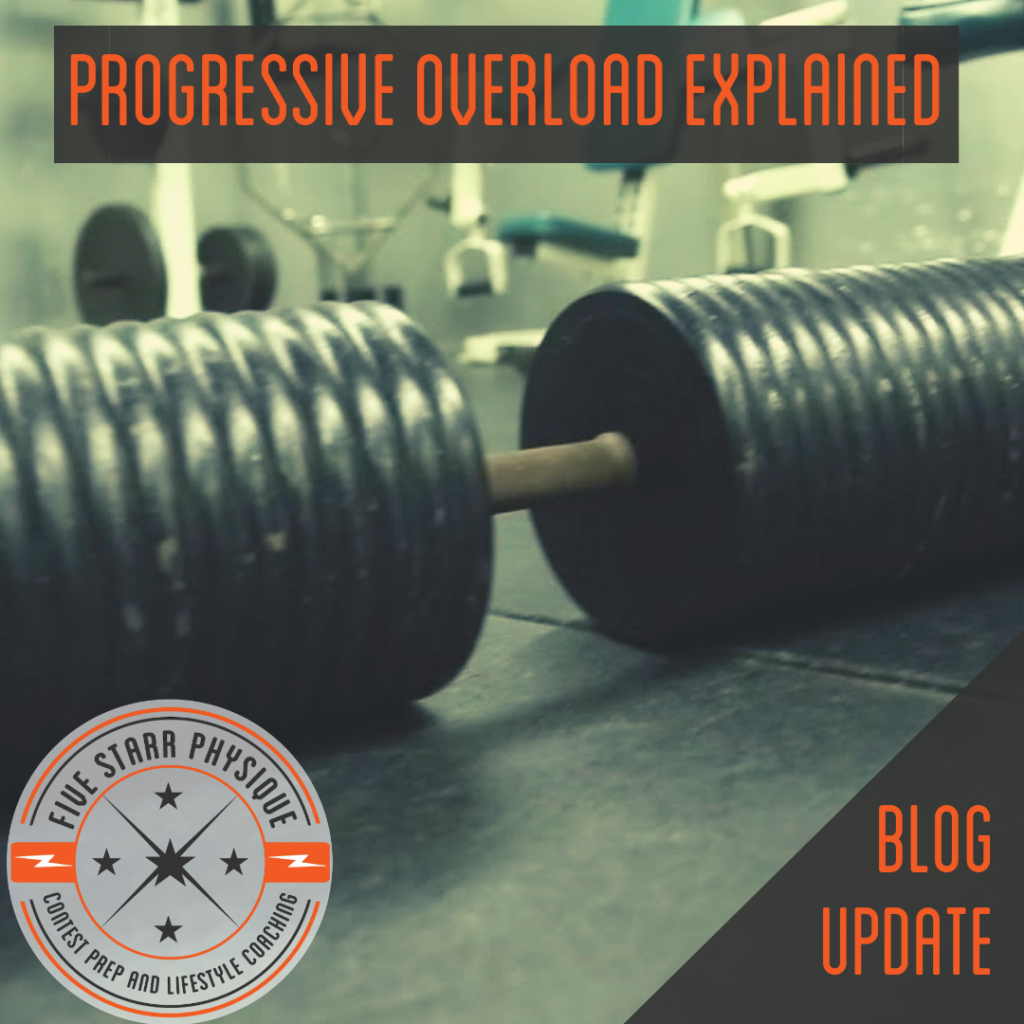
If you haven’t been ignoring me since I started writing these posts or doing my podcast (and really…who could blame you if you have been?) then you know all about my mildly inappropriate infatuation with progressive overload. At it’s core, it is the heart and soul of bodybuilding and the one key area when it comes to building muscle where overthinking is allowed. It does not replace or act as a substitute for busting your ass and nearly killing yourself in the gym on a regular basis, but when applied correctly it can make all of that work more productive and keep you from getting stuck.
Progressive overload is key for building muscle and growing, but it also can’t be overlooked when it comes to keeping your metabolism active and preserving muscle on a cut. Regardless of the phase you’re in, having a mastery of this concept is going to help in a big way.
The big picture concept is pretty basic – the more you lift, the more you grow. If you consistently lift the same weights week after week and month after month, your body won’t change (at least not unless you’re brand new to all of this, in which case you can get results doing practically anything – NOT an excuse to avoid learning the right way to do stuff). Muscle growth is an adaptation to a changing stimulus – if the stimulus doesn’t change and increase in difficulty, what are you expecting your body to adapt to?
Strength vs. Performance
Let’s not confuse this with strength – in bodybuilding and when focusing on development and size, strength is nice but it’s a secondary concern. I’m much more concerned with performance. It’s semantics, but it helps me keep my head on straight.
If you can bench 405 for 3 reps, that’s strong.
If you can bench 110lb DB’s for 12 reps and 3 weeks ago you were barely getting 9 reps with 100’s, that’s a performance improvement.
I don’t care (and you shouldn’t care) about raw, absolute, pound-for-pound weight movement. You SHOULD care about relative output – how what you’re doing now compares to where you were 2, 3, or 6 weeks ago. That’s a key distinction. If I bench 245 for reps and that’s a steady improvement from a month ago, then I don’t really care if dude next to me is hitting 365 for 8 – we’re different people, and we’re not powerlifters (well, I’m not, anyway).
The funny (and probably obvious) thing about progressive overload is that it isn’t indefinitely linear. I may be able to realize a weekly 5 or 10lb increase on my max bench at 10 reps over a 3 or 4 week interval, but clearly that has limits – I’m not adding 250 or 500lbs to my bench over a year. THIS is one of the key reasons to shake up your workout routines on a weekly basis – retire some exercises, bring in new ones, adjust your volume, modify your rep targets, and just overall shake up the configuration of your workouts. If you stick with a set of workouts for 4 weeks (on average), you’ll find it pretty doable to progress over those 4 weeks, and if you’re hitting things aggressively you should be pretty much ready to tap out after week 4, having come close to what feels like your limits.
Beyond Weekly Progression
So week to week progression is part of it – but there’s another element that is every bit as important and that’s set to set progression.
It’s unrealistic (not to mention counterproductive and unsafe) to jump into an exercise right at your maximum weight on the first set. Even if you’re warmed up, you’re just getting into it and your body needs to adjust. While you WILL be fatiguing more as you go from set 1 up through set 4 (or whatever), you’ll also be getting into a groove, moving more efficiently, and improving your skill and technique on the move so I would fully expect you to realize some bumps in weight (and therefore output) as you progress through each set.
There are, of course, limits to this:
- If your form gets sloppy early on in the set, you’ve probably overreached. My general target is to start out neat and clean, and if the last few reps start to look a little messy or “cheat-y”, that’s fine.
- Exercises that use lighter weights, like lateral raises or DB reverse flys – you’re likely not tossing around huge weights here so even a 5lb jump is going to be a big one in terms of percentage of the weight you’re moving. A gym with 2.5lb increment DB’s makes this much easier, but you’ll still find it harder to progress on “lighter” exercises versus something like a leg press
I mentioned at the beginning that progressive overload is the one thing you’re allowed to “overthink” – so let’s dig in to some examples here and see what makes for a good overload strategy. Once you get a feel for it, you’ll learn that it’s not a super vague, nebulous concept but that we’re just looking for more and we’ve got a couple tactics we can employ to get there.
Example 1 (all examples from my own log book)
Machine T-Bar row (3 sets of 12)
Week 1: +90, +115, +125
Week 2: +100, +125, +135
Week 3: +110, +125, +135
Week 4: +125, +135, +145
This is a SOLID 4 week progression. Whenever you’re coming into a new set of workouts, the first week is all about establishing a baseline. Yes, I’ve done a T-Bar row before. But in this split it’s the 3rd exercise on this day, it’s 12 reps, and I’m coming to it straight from high rep pull-ups done to failure so things are getting a little dicey. Comparing this to when I’ve done a T-Bar on a previous split, say for 8 reps as the opening exercise isn’t going to be a fair comparison
Context matters.
So whenever you’re coming into a new set of workouts, consider what you’ve done before but think of those as soft expectations rather than firm limits.
The first week is easy – starting off pretty moderate, squeezing hard, feeling things out. The increases here were difficult but not mind-blowing. I knew going into week 2 that I could handle a little more and so I forced it, starting 10lbs higher and just maintaining that increase through all 3 sets.
One of the key things that increasing the weight from set-to-set does for you is to allow you to focus on a HARD contraction and good form at a sub-maximal weight, and then try to maintain that as the weight increases. This keeps the quality of every rep higher through the entire session.
Going into week 3 I was feeling a BIT off that day and wasn’t sure about increasing the top-end weight, so I just started a bit higher and matched week 2 for the final sets. For week 4 I was feeling good – went for broke and got it.
Example 2 (shit’s getting real now)
Hammer Strength V-Squat – 1×12, 1×10, 1×8, 1×20 (rest/pause style, back off on weight)
Warmup sets in parentheses
Week 1: (+90, +180) +270 for 12, +360 for 10, +450 for 8, +360 for 20 (no rest)
Week 2: (+200, +290), +425 for 12, +515 for 10, +605 for 8, +515 for 20 (no rest)
Week 3: (+200, +400), +490 for 12, +580 for 10, +650 for 8, +580 for 20 (15 and 5)
Only 3 weeks of data here but you can see how crazy it got – nothing like a good rest/pause routine to really open your eyes to what you’re capable of. As soon as I hit that final set on week 1 and pushed through for 20 reps straight (NOT easy), I realized I was selling myself short big time and made BIG jumps going into week 2 (+155 increase on the final set and STILL no pause) so then did the same going into week 3, which was awful and miserable but did exactly what it needed to do.
Example 3 (last one!)
Wide grip pulldown – 2×12, 1×10, 1×8
Week 1: (100), 120, 130, 150, 180
Week 2: (100, 120, 140) 160, 190, 220, 240
Week 3: (100, 120, 140) 160, 190, 210 (8), 230 (6)
Week 4: (100, 120, 140) 170, 200, 230, 250
All rep targets (per set) were hit unless noted in parantheses after the weight. Week 1 was pretty mild and I KNEW I had the potential to really be aggressive in week 2 so I grabbed it and it worked well – for whatever reason (this was back in March so I’m not sure what was going on), week 3 was a clusterfuck and I scaled back my targets and still managed to miss them. Knowing me I was probably distracted because someone was late sending in their peak week update or some trivial nonsense like that (I freak out about lame stuff, it’s kinda my thing). Week 4 I had turned things around and managed some good (difficult) increases from week 2, and that 250lb for 8 on the final set of week 4 was my first time ever pulling that weight for ANY number of reps on a wide grip pulldown.
Conclusion
Progressive overload is best summed up and described like this: it’s a simple concept, but don’t expect to mastery it quickly.
The human factors here are really tricky – ok, we want to do “more”, but what if the body just refuses to cooperate? What I’ve found is that more often than not – especially for beginning and intermediate lifters – you’re capable of doing WAY more than you think at first. We all have, universally, a very well-developed skillset when it comes to selling ourselves short.
Smart programming, good record keeping, and a clear and focused drive on progression is all it takes in most cases to really push the envelope and continue growing.
Check out my bodybuilding workout programs here
Read more about my online coaching program here
